Opublikowane na: Mława (mlawa.pl)
Autor: root@npc.pl
Necropolis
Mława's necropolis became a reflection of social relationships that were formed within the years. Beside Roman Catholic cemeteries in Mława until 1939 there were also five others: two Jewish cemeteries, two evangelical and one orthodox. Of all five only three have survived until the present day. Also deserving attention are the burial places of people that died during World War Two.
Jewish Cemetery
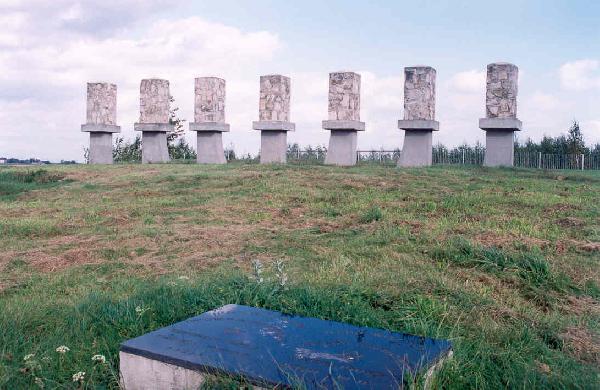 [1]
[1]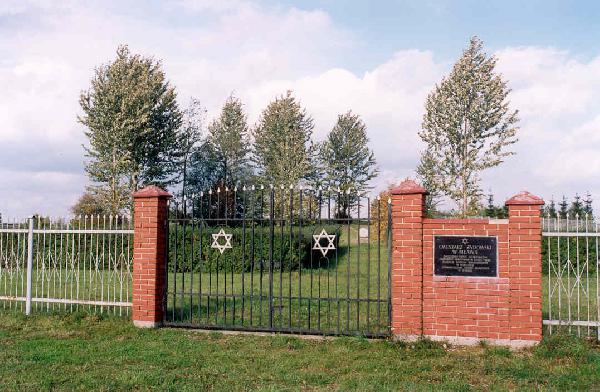 [2]
[2]
| The oldest one was so called "kirkut" founded near Zabrody St (now at the exit of Krucza St). It was created provably at the end of XVII or at the beginning of XVIII century. At that time the Jewish used to inhabit the Zabrody region and there they also had their synagogue. Yet they could not live in the town centre, only on its outskirts. |
| Since about 1850 in Mława there were units of 6 Regiment of Doniecki Cossacks stationed and they had their barracks, stables and a training place between Zabrody St and Warszawska St. So the Jewish cemetery was in the borderland of this military area. Therefore, it could not function properly in such conditions and was limited to a role of a closed cemetery. A new cemetery was founded much farther from the Russian barracks: on a small hill at the exit of Warszawska St. (right behind a present ring road). It was open until 1940, that is until the Jews were crammed into a ghetto. The new cemetery was surrounded with a wall and there lived a cemetery guard whose main duty was to keep the cemetery in order. The destruction of Jewish cemeteries was begun by Germans in 1941 when they started destroying the tombstones and monuments which they used as building material for military constructions in Krzywonoś training centre (near the village of Nosarzewo). Until present there have been preserved two concrete entry poles in which there used to be parts of macewas. After World War Two the Jewish cemeteries (to tell the truth- their remnants) just like orthodox and evangelical cemeteries became no- man's land. |
| Now in the place of the former cemetery there is a monument of Menora founded by the Jews of Mława who live in Israel. It was built with the use of pillars saved from Nosarzewo. They were preserved and placed in the highest point of the cemetery as a sign of savagery. So in that way there was created the first part of a monument whose author is a sculptor Andrzej Borcz. The monument unveiling ceremony took place on 20 July 1998. |
German Soldiers' Cemetry
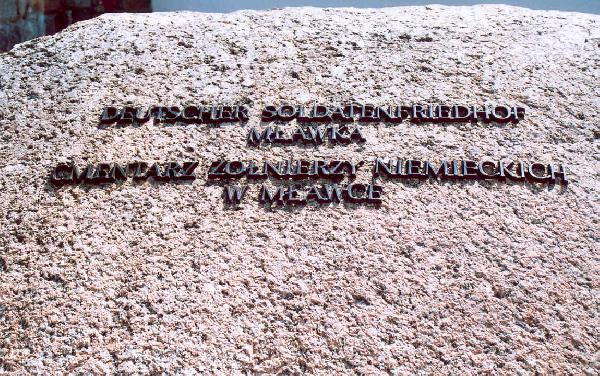 [3]
[3]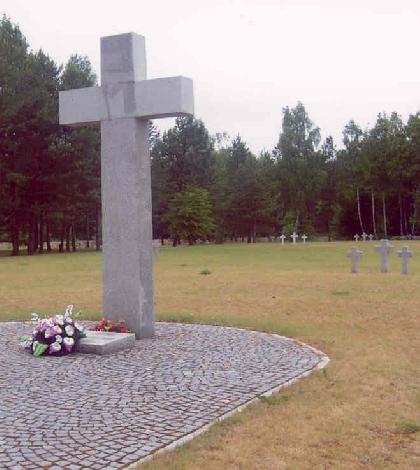 [4]
[4]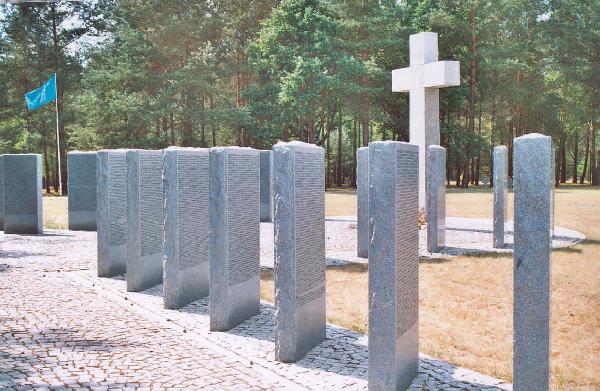 [5]
[5]
In the village of Mławka , situated about 4 kilometres north of Mława, there is a German Soldiers' cemetery. It was founded between 1940 and 1944 by Wermacht soldiers. It was built, among others, by Polish forced labour workers. There are bodies of soldiers killed in both world wars there. The remains of the soldiers of World War One are in separate places . Just during World War Two 1,300 German soldiers were buried in this place. The cemetery was reconstructed during the nineties thanks to German Association of War Graves Carers and Polish Foundation "Pamięć". Currently there are symbolic tombstones of about 12,000 soldiers there, exhumed and brought to Mławka from other cemeteries. There are groups of crosses without nameplates on a lawn separated by narrow paths. Names of buried soldiers are written on stone plates in the central part of the cemetery.
"Kalkówka"
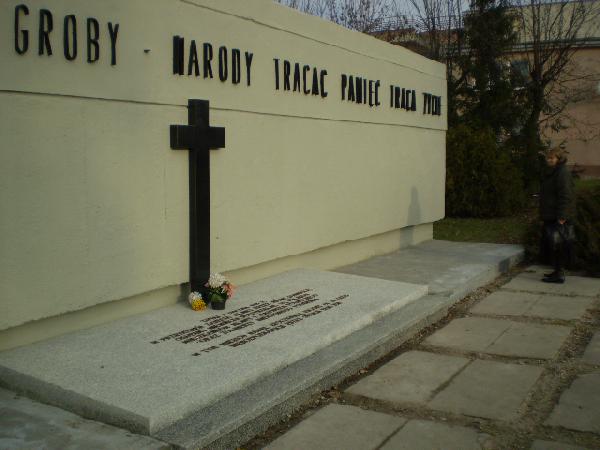 [6]
[6]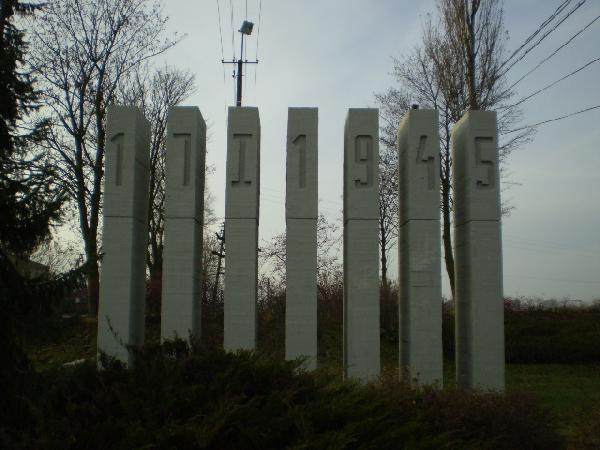 [7]
[7]
Before the outbreak of World war Two the name Kalkówka did not even exist on a map. Not many citizens of Mława knew about its existence. It was only associated with gravel works near Mława. But this place, situated just 500 metres from Mława's borders, in January 1945 was a witness of horrifying events. It was here that a day before the liberation, on 17th January 1945, local military policemen and Gestapo carried out an execution. The crime was committed on the prisoners of Mława, soldiers of Bataliony Chłopskie , Poles who were in jail because of economic offences, Russian captives and accidental passer-bys. 364 people were murdered at that time. Most of them were identified by their families. But about 100 people from all over Poland that were in Mława just by chance at that time, were buried in a common grave next to the gravel works. For many years there was a huge birch cross there as a symbol of victims of World War Two. In 1964 on the initiative of Friends of Mława Land Society in the tragic place there was a monument erected there- a mausoleum. The authors of this monument are Barbara and Andrzej Wachnowie. It has a sarcophagus shape and concrete poles built next to it are a symbol of convicted prisoners awaiting their execution.
Orthodox Cemetery
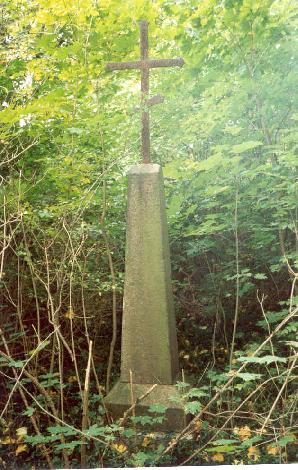 [8]
[8]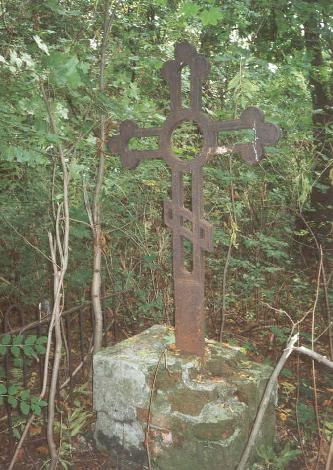 [9]
[9]
It is located next to the council cemetery at the exit of O. Maksymilian Kolbe St. It was founded in the second half of XIX century after tsarist military units, office workers and traders who wanted to enrich quickly had arrived in Mława. For the orthodox people needs there was also an Orthodox church built in 1879 in the western part of the town (within the present park borders). The cemetery had been in use until World war One began. It was a well- situated place in the between the wars years, then after World War Two (since the fifties) as a no-man's land it became devastated very quickly. It used to be overgrown with bushes and thicket, among which there were several broken and devastated tombstones and a few fallen over, big crosses. Now the cemetery has been renovated.
| Protestant cemeteries |
| Right behind the orthodox cemetery there was an evangelical cemetery, much smaller than the orthodox one. The tombstones were situated on both sides of an alley which ended with a high tower. The cemetery was surrounded by a red brick wall. Right after World War Two ended, it became devastated quickly. Now the remnants of the high brick wall are visible. There is no sign of the graves or a chapel. |
| Not much can be said about the second cemetery which until 1939 had only several graves. The cemetery was located at the junction of Płocka St and Bednarska St . About 50 metres ahead along Płocka St there used to be, not existing any more nowadays , an evangelical church, which was situated on Długa St. The church was built in 1870 so we can assume that the cemetery was built at the same time. Until World War One the cemetery was fenced. Between World War One and Two the condition of the cemetery started to get worse. Currently there are blocks of flats in that place. There is no evangelical church either on Długa St or in that part of Bednarska St. where the cemetery used to be located. |
1939 Fortifications
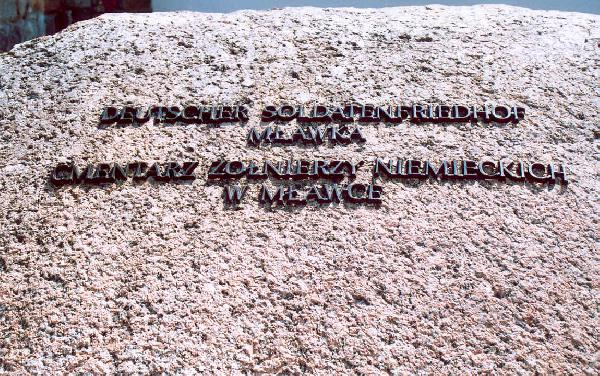 [10]
[10]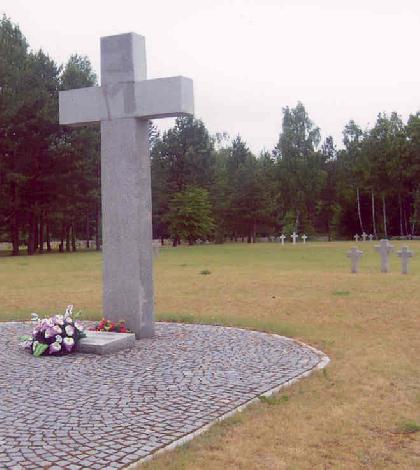 [11]
[11]
| The Zawkrzeńska Land was a borderland for a long time exposed to aggression of the warlike neighbours of the Republic of Poland: Prussians, Germans and Teutonic Knights. Despite the existing threat, until 1939, nothing was done to prevent the country from the attacks and to secure the border although in the times of the Second Republic of Poland it was just 120 km far from its capital. Fortresses in Modlin, Pułtusk and Różan, inherited from the occupants, were too far apart from one another to have any influence on the course of war in that area. The situation changed in 1939, when after the mobilization order, the North Mazovia Region became a place of combat for "Modlin" Army whose brigade's commander was general Emil Przedrzymirski Krukowicz. The main task of "Modlin" Army was to delay the enemy movement heading from east Prussia towards Warsaw, Nidzica and Modlin. |
| This way was the shortest one from Prussia to Warsaw for the German Army. Near Mława, within the operational area of 10 Infantry Division (ID) commanded by Colonel Wilhelm Lawicz- Liszka there were so called "Mława Point" and "Rzęgnowo Point" formed. In the central section of "Modlin" Army operational area, within the operational area of 20 ID, there was a camp fortification built. During its planning the Hills of Mława were taken into account as a natural obstacle. The most convenient for defence was a section from Turza Mała to Rzęgnowo village. According to the plan 68 fortifications should have been built along the northern slopes of Mława Hills and surrounded by the swamps of the river of Mławka valley, up to the swamps of Niemyje. |
| The works near Mława started on 14 July and near Rzegnowo only on 12 August. They were stopped by the war. On the morning of 1 September German forces of 44 thousand soldiers attacked "Mława Point". The German forces included 1 KA consisting of: 11 and 61 Armoured Divisions and an Armoured Division of SS commanded by General Kempf (7,4 thousand soldiers and 160 tanks). "Mława Point" was defended by 16,100 soldiers commanded by Colonel Franciszek Dudziński. The Germans tried to break the defence line marching directly towards it but when they were not able to do so they used all their forces available. |
| Mława's position defence lasted 80 hours and was not broken by the Germans. The retreat of Polish forces was ordered by the commander of the Fortress of Modlin. About 1,200 Polish soldiers got killed and 1,500- injured. German losses were much greater: about 1,800 killed and 4,000 injured or missing. One can include the attempts of breaking the defence of Mławka, Piekiełko , Uniszki Zawadzkie, Kułakowo and Żaboklik to one of the most spectacular battles. |
| Up to the present about 55 different fortifications have been preserved. These are mostly single and double rifle- range fortresses designed for heavy machine guns and several wooden- ground fortifications. The majority of these objects are located in the woods and are not directly visible, which prevents us from seeing all sections at the same time. Beside regular shooting trenches, the remnants of two passive shelters have also survived. |
| The first of the objects saved is situated on the way from Turza Mała to Mława. There was a big resistance point located here (the resistance line of the Second Battalion of National Defense) consisting of five shelters connected together with the whole net of multisection trenches. On the rear wall of one of such shelters somebody engraved the following words: "Corporal W.Olszewski 1 IX 1939". A little further on the way from Mława to Lewiczyn there is a big hill Chochołatka. The trenches form here a small resistance point. Along the valley of the River of Mławka there are other five objects which form a defence line of I and III Battalion of 78 Infantry Regiment. |
| Next shelters are situated on the way from Mława to Działdowo. Beside 5 objects located on both sides of the road, there also used to be a passive vantage shelter built on a hill behind the main defence line. The most interesting of all preserved sections stretches from the hill to the road Mława-Dźwierznia. It consists of two resistance points in a good condition. First of them is situated on Łysa Góra and at its foot. The second one is located on the hill, on the south bank of the river of Mławka. These were the defensive positions of III Battalion of 80 Infantry Regiment commanded by Major A. Jaśkowski. So called "Redoubt Piekiełko", consisting of four constructions which were situated on both sides of the road Mława- Dźwierznia, was supposed to be an additional road blockade. |
| Next three structures are a linking section. Another one is a resistance point defending the road to Gdańsk and consisting of 6 constructions assembled in two lines. In September 1939 these were the defensive points of II Battalion of 80 Infantry Regiment commended by Major Jędrzejczyk. One of the shelters without the back wall, situated there, was adapted for September Soldiers Mausoleum. Its main architectural accent is an anti-aircraft cannon placed next to the bunker. |
| The designers of the mausoleum were the architects Barbara and Andrzej Wachnowie. The mausoleum was created on the initiative of Friends of Mława Land Society. Its unveiling was during the third convention of veterans which took place in 1964. |
| By the northern edge of the forest there are situated other two structures which form another linking section. Further four constructions' task was to defend the road from Mława to Windyki. Further three structures are a resistance point around Łysa Góra and the village of Sławogóra Stara. That was a part of fortifications of I Battalion of 80 Infantry Regiment commanded by Major J.B.Schlichtinger. Mława Section is finished with an atypical structure standing on the verge of Niemyje Swamps. Its construction is designed to spray the enemy with gunfire. Separated from it with a ten-kilometre long swampy area Rzęgnowska fortifications are not preserved so well. Out of all reinforced concrete constructions only six survived. Two of them have some atypical constructions, i.e. horizontal and vertical slats that do not appear in other structures. According to J. Bogdanowski Mława fortification is just a reinforcing line and therefore concrete structures are more exposed in the landscape. They are just a supplement of the ground- wooden fortifications. |
Adres źródłowy: https://mlawa.pl/artykul/necropolis